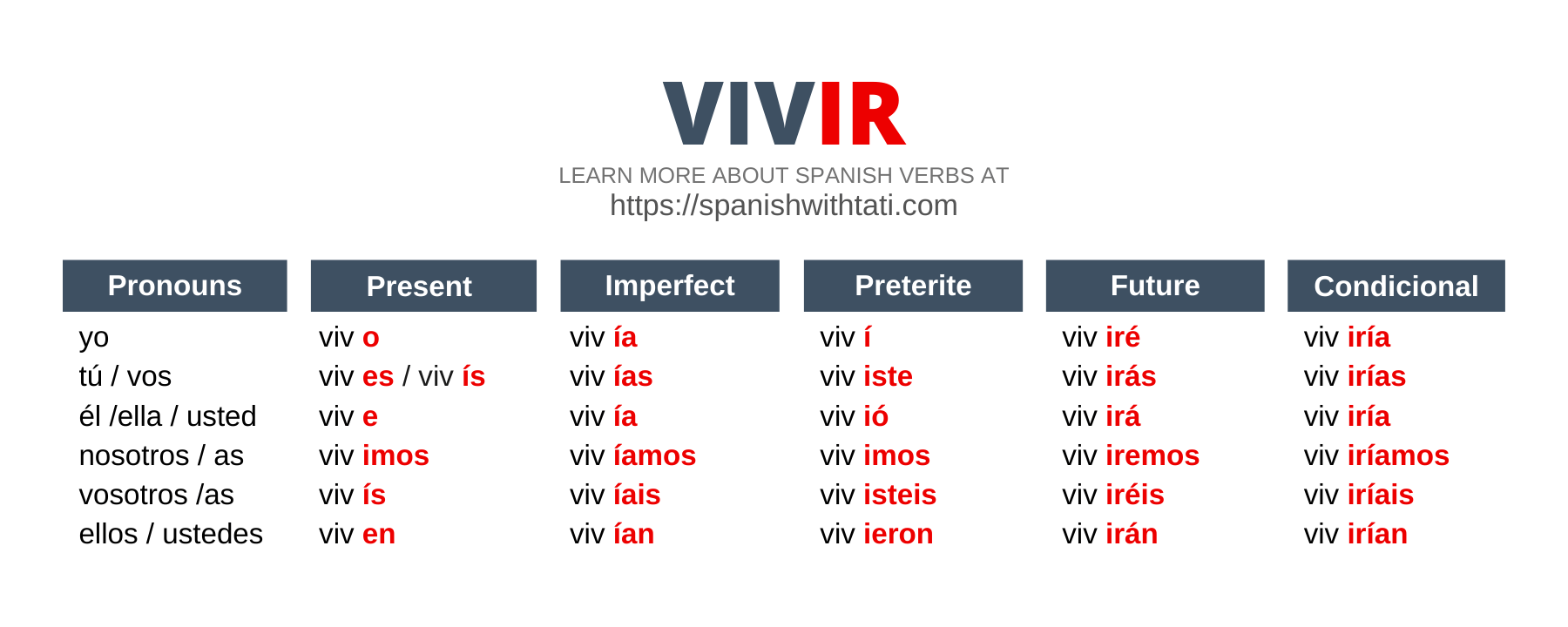

Add new ending depending on who is performing the action. Future tense in Spanish with ir a + infinitive (Informal Future) This form is commonly used in the Spanish future tense to speak about immediate future actions, similar to going to sentences in English. The three irregulars are ser (which becomes, era, eras, era, ramos, eras, eran), ir (which becomes iba, ibas, iba, bamos, ibais, iban) and ver (which becomes. Follow the rules to Conjugate ir or er verbs: Remove the ir or er and add a new ending. Todos los días _ (ir - nosotros) al parque y _ (ver - nosotros) a nuestros amigos. Make sure its a ir or er verb: ir or er verbs are simply verbs that end in ir or er. Lo peor _ (ser) que _ (compartir - yo) un dormitorio con mi hermano. Mi madre _ (estar) contenta porque la casa _ (tener) un jardín muy hermoso. Ĭuando yo _ (ser) más pequeño, _ (vivir - nosotros) en una casa grande en el campo. QuestionĬomplete the paragraph with the correct form of the imperfect tense. Había is used frequently for describing things in the past, eg en mi pueblo había un restaurante (in my village, there used to be a restaurant). The imperfect of hay (there is/there are) is había (there was/there were/there used to be).

To conjugate regular -er and -ir verbs in the imperfect, simply drop the ending (-er or -ir) and add one of the following: ía ías ía íamos íais ían. The gerund is the equivalent of the English verb form, which ends in -ing, eg jumping, singing, working. To conjugate regular -ar verbs in the imperfect, simply drop the ending (-ar) and add one of the following: aba abas aba ábamos abais aban. Lets review the conjugation of the irregular Spanish verbs estar ir and dar. + present participle/gerund ( hablando, estudiando, escuchando música, etc.) Spanish Verb Conjugation: yo estoy t ests l / Ud.

The present participle (which is also called the gerund.The correct form of the verb estar in the imperfect tense.So there you go Nothing special Ir can be used just like any other verb in the imperfect tense. As we already mentioned above, the imperfect Spanish tense is used to talk about past actions, conditions or events that occurred habitually. In all of these examples, you’ll use the imperfect tense for Ir because it’s describing either a person or an event in the past. Like the present continuous tense, the imperfect continuous tense is composed of two parts: Los vecinos iban a montar una fiesta The neighbors were going to have a party. To form the future tense of regular -ar, -er and -ir verbs, add the following endings to the infinitive of the verb. So, just as hablo means I speak, hablar means I will speak or I shall speak. In Spanish you have to change the verb endings. In Spanish, regular verbs in the imperfect tense ( verbos regulares en el pretérito imperfecto) are conjugated by dropping the infinitive endings -ar / -er / -ir and by adding the appropriate endings for each as in the table below. In English we can form the future tense by putting will or its shortened form ’ll before the verb. Preterit vs Imperfect Spanish Worksheet 2. Mi hermano estaba trabajando (My brother was working). Preterite vs Imperfect Spanish Exercise 1.Estaba escuch ando música (I was listen ing to music).This verb base is used for all verbs whether they. Drop the -ron ending to establish the verb’s imperfect subjunctive base. In the case of the imperfect subjunctive, here’s what you do: Start with the third-person plural form of the preterit. The imperfect continuous is used to say what was happening or what you were doing at a particular time. Every Spanish tense and mood has its own quirky procedure you must follow to conjugate the verb.


 0 kommentar(er)
0 kommentar(er)
